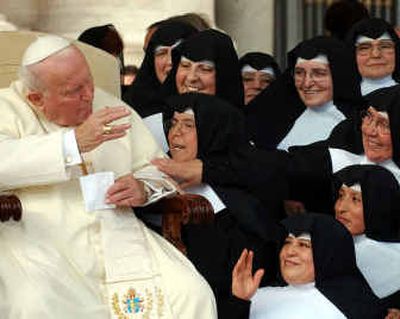Support of women was mixed

PHILADELPHIA – Pope John Paul II was a mixed blessing to Catholic feminists. He held an open hand to women on many fronts, such as career equality, human rights and lay leadership – but he showed the back of his hand on the charged issue of priestly ordination.
Under his guidance, the Code of Canon Law was revised in 1983, and he encouraged women to take a stronger position, especially at the diocesan level.
Women no longer had to be content with taking care of the flowers on the altar or caring for the linens and vestments. Today, women are eucharistic ministers. They are missionaries and minister to the sick. They serve on parish committees and are altar girls.
What they are not, and never would be while John Paul reigned as pope, is priests.
Many Catholic women rankle at that, though they give him good marks for his other stands.
Regina Bannan of Philadelphia, national past president and now local president of the Women’s Ordination Conference, which advocates women in the priesthood, said John Paul, more than his predecessors, was almost “preoccupied” with the issue of the ordination of women.
The pope officially slammed the church door on the ordination activists with an apostolic letter, issued in 1994, “On Reserving Priestly Ordination to Men Alone.” In it, he wrote:
“I declare that the church has no authority whatsoever to confer priestly ordination on women, and that this judgment is to be definitively held for all the church’s faithful.”
He never wavered from that edict.
And, in another apostolic letter, “Mulieris Dignitatem” (“The Dignity of Women”), he wrote:
“In calling only men to be his apostles, Christ acted in a completely free and sovereign manner. … Only the apostles were present at the Last Supper when Jesus instituted the Eucharist and the priesthood.
“Since Christ, in instituting the Eucharist, linked it in such an explicit way to the priestly service of the apostles, it is legitimate to conclude that he thereby wished to express the relationship between man and woman, between what is ‘feminine’ and what is ‘masculine.’ “
Some women are finding ways around those edicts.
“Groups of women are gathering in their homes and celebrate the liturgy without an ordained presider,” said Sheila Durkin Dierks, author of the book “WomenEucharist.”
“And I don’t think it’s a new thing,” Dierks said. “I expect it’s been done for centuries.”
Such a practice violates canon law, said the Rev. Frederick L. Miller, a spiritual director at the Pontifical North American College in Vatican City and formerly a theology professor at St. Charles Borromeo Seminary in Wynnewood, Pa. “Simulating the performance of a sacrament is a grave sin,” he said, though he said he was not aware if the church was trying to stop it.
Dierks called protest liturgies a “quiet ferment” and said many women who participated in them still attended Mass regularly.
In support of the pope is Sheila Garcia, assistant director of the Secretariat for Family, Laity, Women and Youth at the U.S. Conference of Catholic Bishops in Washington.
She said many women did not realize how much the Pope did to improve their church status.
“He allowed women to assume new roles with real leadership and responsibility,” Garcia said. “The role of chancellor of (church law) tribunals has been opened to women. Women are directors of resources. They are on pastoral planning committees. They head family-life offices and are in charge of Catholic health-care organizations.
“While a shortage of priests certainly contributed to this, it was the pope’s real commitment to women that allowed the changes to occur.”
Garcia said the pope acknowledged that history was often one-sided because it had been written by men.
“He called on women’s contributions to be recognized,” she said. “He called for equal pay for equal work, for fairness in career advancement. He saw the need to protect working mothers.
“Violence against women was a major concern, as was sexual exploitation. A big issue for him was discrimination against girls.”
Despite their differing views, Dierks said she admires the pope. “We differ on a number of areas, but if you look at his record on issues for women in the Third and Fourth World countries, he’s done tremendous things,” Dierks said.
“We (in the U.S.) don’t live in a world where women are chattel, where there is female genital mutilation. Those are horrors this pope has addressed very strongly.”
Dierks and Bannan said they believe that John Paul unwittingly spurred the desire for the priesthood because of his advocacy for women.
“Sociology today indicates that women expect to be CEOs, attorneys, physicians, so why not priests? They don’t want to take no for an answer anymore. This pope said yes to many other issues,” Dierks said.
As Garcia pointed out, John Paul encouraged education for all women, and because of that, there are many women theologians today. Some are teaching at seminaries, including the Washington Theological Union and Chicago Theological Union.
“Women today,” she said, “are preparing tomorrow’s priests.”